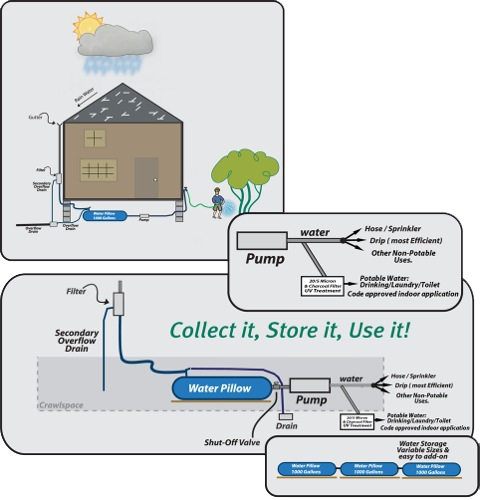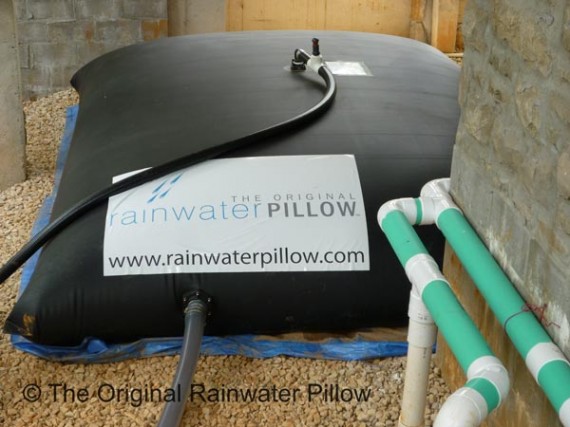The Original Rainwater Pillow and How it Works
Dear Readers,
In addition to our future home, The Seed, being designed upon pins and with super thick, crazy well-sealed walls, we want all of the water that we use to be gathered from precipitation and stored in a pillow. This pillow will be stored within our building envelope (so that it is insulated) and underneath our floor. Imagine a giant waterbed in your basement thats purpose is to provide you with showers and clean drinking water. That’s it.
The rainwater collection system we intend to use is called The Original Rainwater Pillow, created and sold by a gentleman named Jim Harrington. Based in Georgia, he was inspired to develop the rainwater pillow in 2008 during a period of intense drought in his area. Six years later, in 2014, his Original Rainwater Pillow won the U.S. Green Building Council’s (USGBC) Best of Building award for Best Product for Water Efficiency! We are excited to test out the Original Rainwater Pillow in The Seed…but first, how does it work??

Diagram of how the Rainwater Pillow works, Credit: The Original Rainwater Pillow
How it works
The Pillow tanks are specifically built horizontally to fit into ‘wasted spaces.’ Think crawl spaces, under decks or porches, basements…that way, the need for excavation for cisterns or a giant tank in the yard is eliminated. And what is additionally so genius about the Pillows, is that they are relatively easy to install- like a deflated air mattress, they are easy to transport and lighter to move around (which is wonderful for prefabrication mind-sets). We intend to keep our Pillow within the thermally controlled building envelope of our home: above the pins and right below our floor.
Rainwater harvesting all begins with rain and a roof. Your roof is kind of like your ‘rain catcher’…the larger the square footage that your roof covers, the more potential you have for more water. As the rain runs from your roof to the gutter system, it will travel to your downspouts and then go through a pre-filter. The pre-filter is intentionally ‘coarse.’ It allows water to move quickly through it during heavy downpours, while simultaneously separating leaves or other large debris.
If the Pillow will be used for potable water storage (which ours will be), then additional filtration is needed before gravity carries the water to the Pillow tank. Jim Harrington recommends the use of a Wisy Downspout Filter, which directs debris to storm water run off, and the clean water to the rainwater pillow. The Wisy Downspout Filter also acts as a ‘first flush’ device. A ‘first flush’ removes further debris- about “the first 10% or so of rainfall, which contains the highest amount of debris from entering the pillow.” 1 Gravity then continues to carry the water away to its holding Pillow…
Once the water is in the Pillow, it should be aerated every now and again to prevent anaerobic decomposition (you’ll hear more about that when we introduce our composting toilet). Otherwise, you basically just let it sit there! Then, you turn on the kitchen faucet for a glass of water….
Pumps are used to carry the water out of the Pillow. As the water exits, it will go through a four stage filtration system:
First, filter the water through a 20-25 micron filter.
Second, filter the water through a 5 micron filter (just keep gettin’ smaller…).
Third, the water is treated with UV Light which sterilizes any remaining organisms.
Fourth, use a 1 Micron Charcoal Block to filter and absorb super fine debris.
And ta-da! A clean, clear glass of water fresh from your Pillow.
Maintenance
There is some understandable maintenance that will be required for our eventual Rainwater Pillow. First, the gutters. Because the gutters work hand-in-hand with your roof to catch rainwater, they are much more efficient when they are clean. Same with the pre-filter. The less leaves, sticks, pinecones, gravel, dog toys, and other miscellaneous objects that can end up on a roof and fall into your gutter, the better. There is an overflow with the Rainwater Pillow system, and if the gutter or pre-filter are clogged, the rainwater will go into the overflow, and not your Pillow tank. They recommend that the gutters be cleaned regularly (depending on the time of year and location of home) and that the filter be cleaned after every rainfall.
The fittings and threaded connections on the Pillow should also be checked every six months. The fittings are bolted to the Pillow material, and may simply need tightened (use a wrench and turn them clockwise). Same with the threaded connections…if they are loose, you may incur moisture problems.
What is the Pillow made of?
Lots of cool stuff. It is composed of a reinforced polymer alloy, which is the “same heavy duty industrial strength fabric… used by the military and fire departments.” The seams of the pillow are “radio frequency welded,” which means that they used “electromagnetic energy to heat and bond materials together under pressure, ensuring strong, leak-proof seams.”
So, what does all of this mean as far as the Pillow’s strength? Well, they claim that “every square inch of the Original Rainwater Pillow can withstand friction more than 2,000 times before it begins to abrade,” as tested by a third party lab, ASTM. They also state that a one-inch strip of the Pillow’s material can hold up to 550 lbs. As far as weather resistance goes, the material can withstand extreme temperatures ranging from -30 to +160 degrees Fahrenheit.
Especially since William and I intend to put our Pillow within our home’s thermal building envelope, we do not need to worry about the water within the Pillow freezing. The water’s initial pathway to its Pillow tank (the gutters, downspout, piping) is at risk of freezing during periods of melting and refreezing in extreme, consistent, colder temperatures (think Siberia or Canada). The pipes are above the full height of the pillow, and allow excess water to be drained to the overflow (so it does not sit in the pipes), so freezing pipes in our lil’ county in central PA is not too much of a concern. However, the lack of liquid water during the winter months is a potential concern…Something to think about!
Example of Inflated Pillow, Credit: The Original Rainwater Pillow
How do you know what size Pillow tank you would need?
William and I found an incredibly nifty little calculator provided (for free!!) by Second Rain (they develop and sell their own ‘rain benches,’ while also providing rainwater harvesting education and enlightenment). Please do feel free to check them out~they are another great option for harvesting rainwater!
Their calculator is essentially an Excel spreadsheet which calculates the amount of water you could be/should be saving per month according to where you live and rainfall patterns. Here is a brief breakdown of their system…
First: How many people live in your home? They all use water…
Second: What state do you live in?
Third: What city do you live in?
Fourth: On average, how many gallons of water does one person use per day? Think toilet flushing, hand washing, brushing teeth, doing dishes, washing clothes, washing yourself, watering the plants…dog…cats…chickens…oh! And drinking water (it is important to stay hydrated) and using water to cook…lots o’ water…
Fifth: Your roof being the main ‘rain catcher,’ you need to know the square footage that it covers (take the width multiplied by the length of your home. This number is called the ‘catchment area’).
The Second Rain Calculator will then use all of that given information, as well as information provided by the U.S. Geological Survey on average rainfall in your area per month, to give you an estimate on how many gallons of water you should be trying to store a month.
William and I are admittedly very curious as to the average amount of gallons of water we actually use per day…we have set up a bit of an experiment for ourselves, which we are eager to share with you in the next blog…so stay tuned!! Until then, to conclude our current written piece, the Original Rainwater Pillow is one option among many rain harvesting techniques. William and I are particularly interested in the Pillow for its use of wasted space in a home. We are excited to try it out, and, of course, tell you all about it!
We also want to give a sincere, and huge, ‘Thank You!’ to Jim Harrington for looking over our blog and speaking with us about the Original Rainwater Pillow. We look forward to working with him when we build our own home!
Sincerely,
Shelby Aldrich
1. Rainwater Collection Solutions, Inc. “Potable Water Filtration,” The Original Rainwater Pillow, 2018. http://rainwaterpillow.com/system-design/potable-system. Accessed on 29 March, 2020.
7 Comments
Submit a Comment
© 2020 Sustaining Tree
© 2020 Sustaining Tree


Hi Shelby, So, I am so proud of the two of you for this effort, that I DO read it to learn more also. So I do have a question. After your water goes through all of the steps, and it is ok to drink, what happens if you go on vacation for say, two weeks. When you come back, will the water be somewhat stagnant from sitting their so long without being used?
Hey Aunt Rose! That is a really great question (and one of the reasons we are doing this blog is so that we can get questions like that…it brings up points we may not have thought about in our home’s design process…so thank you!!). After our research, how I understand it to work, is that the water in the pillow does need to be aerated every now and again to prevent the organic matter present in rainwater from getting nasty or stagnant. When you are constantly using the water from your pillow, the aeration occurs naturally. But you do bring up a great point…what happens when you leave for two weeks? I believe there is an aerator that you can get with your rainwater pillow so that it automatically aerates the water. However, I am not sure how that works…I shall contact those at The Original Rainwater Pillow, and let you know their response! Thank you so much for reading and for your thought provoking question!!
Hey Aunt Rose! Mr. Harrington replied to my e-mail: “Drinking water systems are set up to automatically aerate with water each day. It is an important part of the water treatment process.” So, to answer your question, you could leave for that two week vacation and then return to safe, clean drinking water!
^lol I figured that someone would need to come by and water the chickens and whatnot, so a house or pet sitter could also help with aeration…I was wondering about it, though, so good to know it’s not something terribly complicated, but I guess it’s an extra expense or is the aerator included with the standard set-up?
We were questioning what else you would need as well, but Mr. Harrington reassured us, if you buy the complete potable kit, it should come with everything you need – including the aerator.
I would
Like to
Instal water pillow to collect rain water. Need more information pricing installation etc
Hello! We are not the manufacturer or the seller of the rainwater pillow, but you can check out The Original Rainwater Pillow’s website, here: https://rainwaterpillow.com/.
William and I have decided not to use the Rainwater Pillow for our project, as it does not meet certain material requirements for the Living Building Challenge. However, if you reach out to the folks at The Original Rainwater Pillow, I’m sure they would be more than willing to provide information on pricing and installation!
Thanks for reading!! 🙂